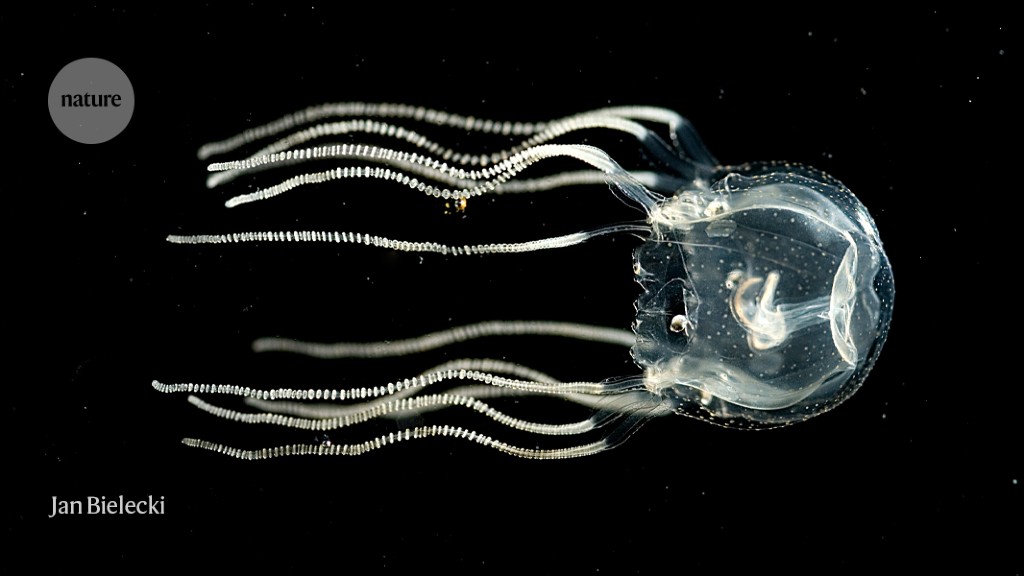How to train your jellyfish: brainless box jellies learn from experience

Researchers have shown that the creatures can learn to avoid obstacles using visual and mechanical cues, despite not having a brain

Caribbean box jellyfish (Tripedalia cystophora) can learn to associate a particular visual cue with a bumping sensation.Credit: Jan Bielecki
A tiny jellyfish has, for the first time, demonstrated a mighty cognitive capacity — the ability to learn by association. Although it has no central brain, the finger-tip-sized Caribbean box jellyfish (Tripedalia cystophora) can be trained to associate the sensation of bumping into something with a visual cue, and to use the information to avoid future collisions.
The experiment shows a type of learning called associative learning — made famous by neurologist Ivan Pavlov’s experiments with dogs in the late-nineteenth century — in which an animal learns to associate one stimulus with another through training. “Associative learning is now considered solid evidence of cognitive capacity,” says Ken Cheng, an animal behaviour researcher at Macquarie University in Sydney, Australia. Many other animals — from humans to birds, octopuses and even insects — have the ability to learn by association.
“The box jellyfish finding is very important because it shows that a centralized nervous system, or brain, is not necessary for associative learning,” says Pamela Lyon, a cognitive biologist at the University of Adelaide, Australia.
“It’s super,” says Gaëlle Botton-Amiot, a neurobiologist at the University of Fribourg in Switzerland, who published a study in March1 showing that the sea anemone Nematostella vectensis is also capable of associative learning. Sea anemones and jellyfish both belong to a group of organisms known as cnidarians, and Botton-Amiot thinks that “this ability to do associative learning is present across probably the entire cnidarian tree”.
Natural test
The sea anemone experiment by Botton-Amiot and her colleagues involved training the animals to associate a bright light with an electric shock. But these stimuli aren’t found in the anemones’ natural environment, and therefore the observed learning might not be biologically meaningful, says Jan Bielecki, an electrophysiologist at Kiel University in Germany who co-authored the jellyfish research, published on 22 September in Current Biology2. “We were very, very careful to make this as natural for [the jellyfish] as possible,” he says.
In the wild, T. cystophora forage for tiny crustaceans between the roots of mangroves. To mimic this environment, Bielecki’s colleagues at the University of Copenhagen placed the box jellies in cylindrical tanks that had either black and white or grey and white vertical stripes on the walls. To the jellyfish, the dark stripes looked like mangrove roots in either clear or murky water.
In the ‘murky water’ tanks, the jellyfish bumped into the wall because their visual system couldn’t detect the grey stripes very clearly. But after a few minutes — and bumps — they learnt to adjust their behaviour, pulsing rapidly to swim away from the wall when they got too close. “It was only when they had a combination of visual stimulation and mechanical stimulation that they would actually learn something” says Bielecki.
He adds that he was unsurprised by the results. “This is just a matter of basic survival,” he says. When the water is murky, jellyfish can’t detect obstacles clearly with their simple eyes, so they need to learn to avoid them to prevent injury. “They can’t just keep bumping into obstacles on turbid days,” Bielecki says.
“There are good lessons to learn from this study,” says Cheng. “If we pick some arbitrary task, the animal may not learn. And that just may be because you’re trying to do the wrong thing rather than the animal not having the capacity.”
“It’s great that they chose something that is really biologically relevant,” says Botton-Amiot.
Physiology probed
To better understand the mechanisms at play, Bielecki dissected out individual rhopalia — small ‘eye-brain’ complexes in the jellyfish, each containing six rudimentary eyes plus nerve centres, called pacemakers, that control the animals’ swimming pulses.
With the isolated rhopalia facing a projector screen, Bielecki could precisely record electrical activity in the nerves when the visual system perceived a visual cue — grey bars moving slowly from one side of the screen to the other. A mild electric shock to the motor neurons mimicked the bump on a jellyfish’s body. Bielecki recorded the nerve activity of the swim pacemakers that caused the rapid swim pulses in the jellies.
Just like the living box jellies in tanks, excised rhopalia could be trained to associate an electrical ‘bump’ with the appearance of a grey bar. After five minutes of training with the grey bar and the ‘bump’, the rhopalia responded to the visual cue alone by increasing their swim-pulse frequency. This confirms that the rhopalia are “where learning happens”, says Bielecki.
How T. cystophora process and coordinate the learning in each of their four rhopalia remains to be understood, says Botton-Amiot. “If you have four centres like this, how is this coordinated?” Whether the creatures retain the learning — and for how long — would also be interesting questions to investigate, she adds.
“There’s a lot more to unpack about what’s going on in this learning,” says Cheng. Identifying the genes and biochemical pathways involved could help scientists to trace the evolutionary origins of learning, as could a better understanding of which organisms are unable to learn. “We actually need the negative data”, he says, that scientists might be shelving. He suggests that researchers should consider whether animals without nerves are capable of learning. “The more distant [evolutionary] branches we look at, the better we have an idea of when associative learning would have evolved.”
Bielecki has more practical goals in mind. He is hoping to adapt findings about how jellyfish learn at the cellular level to non-biological systems, so that robots can learn to recognize patterns. “That’s the future of the jellyfish brain,” he says. “We want to stick them on a chip.”
doi: https://doi.org/10.1038/d41586-023-02975-x
This story originally appeared on: Nature - Author:Dyani Lewis


















